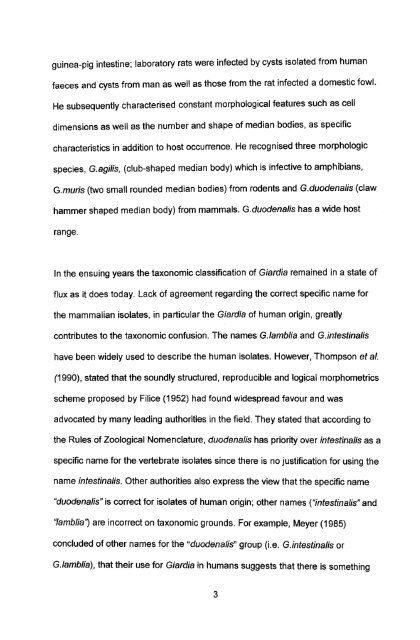in vitro culture and isoenzyme analysis of giardia lamblia
in vitro culture and isoenzyme analysis of giardia lamblia
in vitro culture and isoenzyme analysis of giardia lamblia
You also want an ePaper? Increase the reach of your titles
YUMPU automatically turns print PDFs into web optimized ePapers that Google loves.
gu<strong>in</strong>ea-pig <strong>in</strong>test<strong>in</strong>e; laboratory rats were <strong>in</strong>fected by cysts isolated from human<br />
faeces <strong>and</strong> cysts from man as well as those from the rat <strong>in</strong>fected a domestic fowl.<br />
He subsequently characterised constant morphological features such as cell<br />
dimensions as well as the number <strong>and</strong> shape <strong>of</strong> median bodies, as specific<br />
characteristics <strong>in</strong> addition to host occurrence. He recognised three morphologic<br />
species, G.agilis, (club-shaped median body) which is <strong>in</strong>fective to amphibians,<br />
G.muris (two small rounded median bodies) from rodents <strong>and</strong> G.duodenalis (claw<br />
hammer shaped median body) from mammals. G.duodenalis has a wide host<br />
range.<br />
In the ensu<strong>in</strong>g years the taxonomic classification <strong>of</strong> Giardia rema<strong>in</strong>ed <strong>in</strong> a state <strong>of</strong><br />
flux as it does today. Lack <strong>of</strong> agreement regard<strong>in</strong>g the correct specific name for<br />
the mammalian isolates, <strong>in</strong> particular the Giardia <strong>of</strong> human orig<strong>in</strong>, greatly<br />
contributes to the taxonomic confusion. The names G.<strong>lamblia</strong> <strong>and</strong> G.<strong>in</strong>test<strong>in</strong>alis<br />
have been widely used to describe the human isolates. However, Thompson et al.<br />
(1990), stated that the soundly structured, reproducible <strong>and</strong> logical morphometrics<br />
scheme proposed by Filice (1952) had found widespread favour <strong>and</strong> was<br />
advocated by many lead<strong>in</strong>g authorities <strong>in</strong> the field. They stated that accord<strong>in</strong>g to<br />
the Rules <strong>of</strong> Zoological Nomenclature, duodenalis has priority over <strong>in</strong>test<strong>in</strong>alis as a<br />
specific name for the vertebrate isolates s<strong>in</strong>ce there is no justification for us<strong>in</strong>g the<br />
name <strong>in</strong>test<strong>in</strong>alis. Other authorities also express the view that the specific name<br />
"duodena/is" is correct for isolates <strong>of</strong> human orig<strong>in</strong>; other names ("<strong>in</strong>test<strong>in</strong>alis" <strong>and</strong><br />
"/amb/ia') are <strong>in</strong>correct on taxonomic grounds. For example, Meyer (1985)<br />
concluded <strong>of</strong> other names for the "duodenalis" group (i.e. G.<strong>in</strong>test<strong>in</strong>alis or<br />
G.lamb/ia), that their use for Giardia <strong>in</strong> humans suggests that there is someth<strong>in</strong>g<br />
3
















